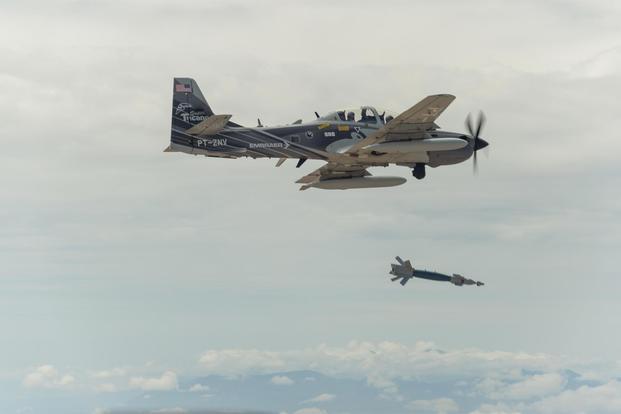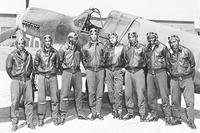Lawmakers have been pressing the U.S. Air Force the last few weeks about its light attack program. The service says that light attack, dubbed OA-X, will be an example of how it intends to buy and field planes faster in the near future.
Leaders have been working on light attack for nearly a year, and they're no closer to procuring a new aircraft than when the effort began. Despite the fact the service says the A-10 Thunderbolt II is not nearing retirement, some wonder some wonder if light attack may be a viable substitute.
But some believe it's unlikely that an actual program of record will be begun for a replacement. A history of light attack shows why.
Four aircraft: The Air Force in 2016 announced that it had plans to hold flight demonstrations with a handful of aircraft to test whether lighter, inexpensive and off-the-shelf aircraft may be usable in ongoing wars such as Afghanistan.
Four aircraft -- AirTractor and L3's AT-802L Longsword; Sierra Nevada and Embraer's A-29 Super Tucano; and Textron and AirLand LLC's Scorpion, as well as their AT-6B Wolverine -- conducted live-fly exercises, combat maneuver scenarios and, on some occasions, weapons drops during a demonstration at Holloman Air Force Base, New Mexico, in August 2017.
Related content:
- Congress Eager for Results of Air Force's Light Attack Aircraft Demo
- Lawmakers Back $400 Million for Possible A-10 Successor
- Air Force Mulls Low-Cost Fighter Experiment
In November, key lawmakers agreed to provide the Air Force with $400 million to continue exploring and experimenting with the planes.
Support from Congress: Senate Armed Services Committee Chairman Sen. John McCain endorsed the Air Force's decision to pursue a future buy, but stressed the aircraft cannot replace the A-10 Thunderbolt II, the service's top close-air-support mission aircraft. The Arizona Republican last January released his white paper assessment on how the Defense Department should move forward in military spending.
"The Air Force should procure 300 low-cost, light-attack fighters that would require minimal work to develop," McCain said in the paper.
The service has not said how many aircraft it expects to procure.
"What you told us about the light attack aircraft and the process is incredibly encouraging, and I hope that you will be able to continue along those lines," Sen Angus King, I-Maine, told Air Force officials during a hearing on Capitol Hill in December.
Down to 2: In February, the Air Force said it will test the Textron Aviation AT-6 Wolverine and the Sierra Nevada/Embraer A-29 Super Tucano during Phase II of the experiment from May to July 2018 at Holloman. (Officials originally chose Davis-Monthan Air Force Base, Arizona, for testing, but have since moved it. "By executing Phase II of the experiment at Holloman AFB, we can take full advantage of the experimentation support construct and logistical capacity that's already been established," Air Force spokeswoman Capt. Emily Grabowski recently told Military.com.)
The reasoning: The service has said the prolonged conflict in the Middle East, with the Islamic State and other extremist groups extending their influence in the region, is the impetus for buying another plane -- but one that won't cost taxpayers a fortune. The Air Force also believes the light attack program is a stepping stone toward smoother acquisition processes in the future.
In just five months from the original March 5, 2017, proposal, the service "had forward aircraft on the ramp at Holloman Air Force Base in New Mexico to test," Air Force Secretary Heather Wilson said March 14.
"This is the way the Air Force should be doing things," she said before a House Appropriations Defense subcommittee hearing on the fiscal 2019 budget request.
"If we decide to move forward, I think we should move forward quickly, and we'll work together with Congress to get the necessary authorizations and the plan that makes sense to do the acquisition," Wilson said.
Air Force Chief of Staff Gen. David Goldfein told Military.com in September that the light attack initiative should be viewed as a new way of doing business -- not just a plane, but part of a larger communications system.
OA-X "is actually not about the hardware -- it's about the network," he said, adding he wants the service to train more often with coalition partners, who may not have high-end fighter aircraft.
"At the same that we're looking at a relatively inexpensive aircraft and sensor package, can I connect that into a network of shareable information that allows us to better accomplish the strategy as it's been laid out?" he said.
The likelihood of light attack becoming a real program? Slim, according to defense analysts.
"You're talking about an enormous amount of money when there's so many other, higher priority candidates," explained John "JV" Venable, a senior research fellow for defense policy at The Heritage Foundation. Venable flew F-16 Fighting Falcons throughout his 25-year Air Force career.
Venable said the service has billions invested into the F-35 Joint Strike Fighter, B-21 Long Range Strike Bomber, and KC-46 Pegasus refueling tanker programs. The Air Force is also revitalizing its nuclear enterprise, with planned investments in nuclear command and control, communications, and new Intercontinental Ballistic Missiles and nuclear-tipped cruise missiles.
"Light attack is somewhere between seventh or eighth down that pecking order, and I don't see it ever getting funded," he said in a recent interview with Military.com.
Venable said he estimates the actual procurement and fielding of light attack would cost somewhere between $3.5 billion to $4 billion.
"My recommendation to the Air Force? Don't do it. Spend money elsewhere on your other priorities," he said.
Venable did say even the Air Force's optics of showing interest in light attack helps other allies come to the table to buy off-the-shelf aircraft.
"[The Air Force has] a really good point that nations can't afford an F-35, but they can afford these," he said. "And if one of our friends can afford this level of platform, then we can get that mil-to-mil exchange going."
Light attack will not be the A-10: Venable said either the A-29 or AT-6, the last two aircraft the Air Force is considering, will never and can never bring the same airpower to a battlefield as the A-10 can.
"There's twice the amount of munitions on the A-10," he said. "It will never be a replacement. It's not something we would use in the next major campaign."
Venable added, "The situation you can put those aircraft in cannot withstand what an A-10 can. The A-10 is the aircraft you want in those [danger close] situations because it offers a great deal of protection for the pilots."
-- Oriana Pawlyk can be reached at oriana.pawlyk@military.com. Follow her on Twitter at @Oriana0214.










